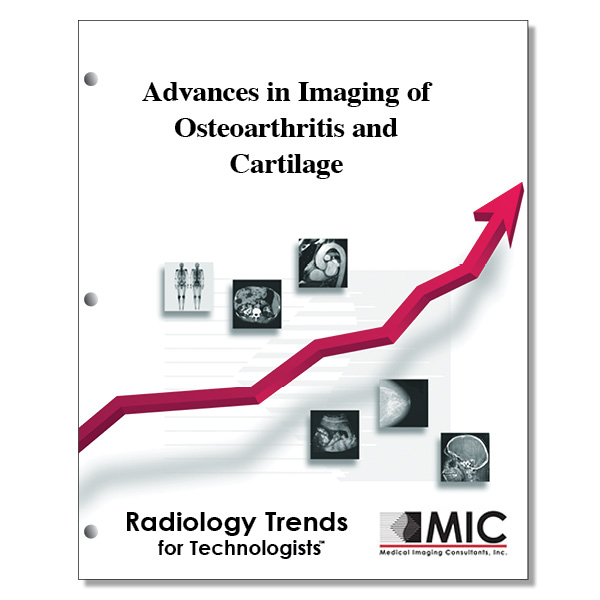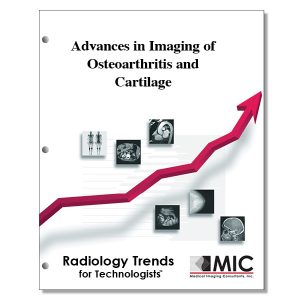

Advances in Imaging of Osteoarthritis and Cartilage
A review of osteoarthritis imaging and cartilage assessment with an emphasis on recent advances.
Course ID: Q00330 Category: Radiology Trends for Technologists Modalities: MRI, Radiography3.5 |
Satisfaction Guarantee |
$37.00
- Targeted CE
- Outline
- Objectives
Targeted CE per ARRT’s Discipline, Category, and Subcategory classification for enrollments starting after June 11, 2024:
[Note: Discipline-specific Targeted CE credits may be less than the total Category A credits approved for this course.]
Magnetic Resonance Imaging: 3.00
Patient Care: 0.50
Patient Interactions and Management: 0.50
Procedures: 2.50
Musculoskeletal: 2.50
Radiography: 1.00
Patient Care: 0.50
Patient Interactions and Management: 0.50
Procedures: 0.50
Extremity Procedures: 0.50
Registered Radiologist Assistant: 3.00
Procedures: 3.00
Musculoskeletal and Endocrine Sections: 3.00
Sonography: 1.00
Patient Care: 0.50
Patient Interactions and Management: 0.50
Procedures: 0.50
Superficial Structures and Other Sonographic Procedures: 0.50
Outline
- Introduction
- Role of Radiography and Recent Developments
- The Role of MR Imaging
- MR Imaging-based Whole-joint Assessment of Knee OA with Semiquantitative Scoring Methods
- MR Imaging Techniques for Morphologic Assessment of Cartilage
- MR Imaging Field Strength, Extremity MR Imaging, and Weight-bearing MR Imaging
- Quantitative Morphologic Cartilage Assessment
- MR Imaging of Biochemical Properties of Articular Cartilage
- Evaluation of Cartilage Repair
- The Role of US
- Treatment
- Outlook
Objectives
Upon completion of this course, students will:
- be familiar with the types of synovial joints
- understand the most common types of arthritis
- describe the role of conventional radiography in diagnosing osteoarthritis of the knee
- understand the role of MRI in evaluating knee joint cartilage and its biochemical composition
- understand predisposition factors that may lead to getting osteoarthritis
- understand the new MR imaging techniques used in diagnosing osteoarthritis
- know the significance of joint space width and presence of osteophytes in the knee
- understand the grading system as described by the Kellgren-Lawrence system
- understand the grading system as described by Osteoarthritis Research Society
- be familiar with the different criteria for joint space width measurements
- understand the radiological signs on a knee radiograph to diagnose osteoarthritis
- describe positioning of the knee to obtain the Lyon-Schuss projection
- describe the difference between the Lyon-Schuss position and fixed flexion position/radiographic view
- understand how cartilage is assessed using the Outerbridge scale in a clinical setting and its grading system parameters
- describe the three semiquantitative scoring systems for whole organ assessment of knee osteoarthritis
- understand the grading system of the Osteoarthritis Research Society international atlas classification
- describe the types of joint space width measurements in each imaging modality and its role in diagnosing osteoarthritis of the knee
- understand the three semiquantitative scoring systems for whole organ assessment of knee osteoarthritis
- understand the benefits of using fat suppression techniques in MRI of the knee for evaluation of the cartilage
- understand the benefits of using SPGR MRI techniques in the assessment of knee cartilage
- understand the benefits of three dimensional DESS MRI in evaluating knee cartilage
- describe the semiquantitative scoring systems for knee osteoarthritis and what WORMS, KOSS and BLOKS stand for
- understand the basic MRI protocols and planes for imaging the knee for osteoarthritis
- understand the limitations of low-field MRI orthopedic units
- understand the benefits of using a 3T MRI system
- understand the benefits of a dedicated, low-field extremity MRI system
- understand which magnetic field strengths are used for research only
- describe what can be assessed from quantitative measurement of cartilage morphology in a MR scan
- understand the limitations of using cartilage volume as a determining factor in discriminating between a healthy patient and one with osteoarthritis
- describe the risk factors for cartilage loss as identified with quantitative measurement of cartilage morphology
- know what type of electrical charge glucosaminoglycans possess
- understand what is symptomatic of the earliest stages of cartilage degeneration
- understand the strengths and weakness of each MR imaging technique for morphologic assessment of knee cartilage
- understand the benefits and limitations of 23NA (Sodium) MRI
- understand how T2 mapping in MRI describes the composition of hyaline articular cartilage in the knee joint
- describe what In vivo MR imaging studies of knee cartilage reveal
- understand the common surgical interventions to repair damaged knee cartilage
- understand how knee cartilage is evaluated after surgery using MRI
- understand the role of T2 mapping in evaluation knee cartilage post-surgical repair
- understand the disadvantages of using diagnostic ultrasound for evaluation of the knee for osteoarthritis
